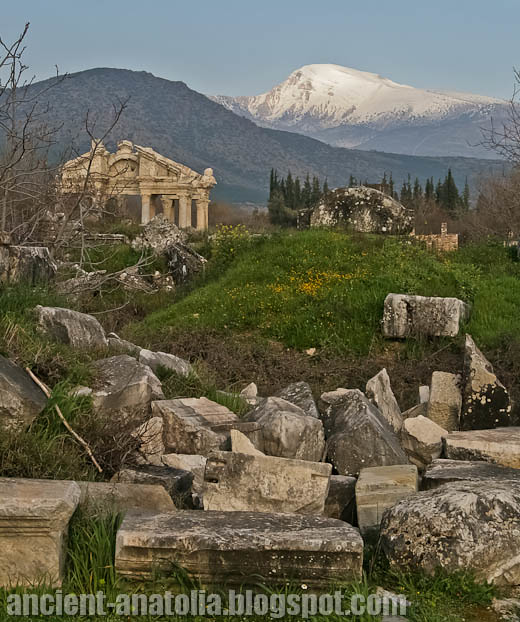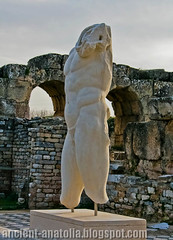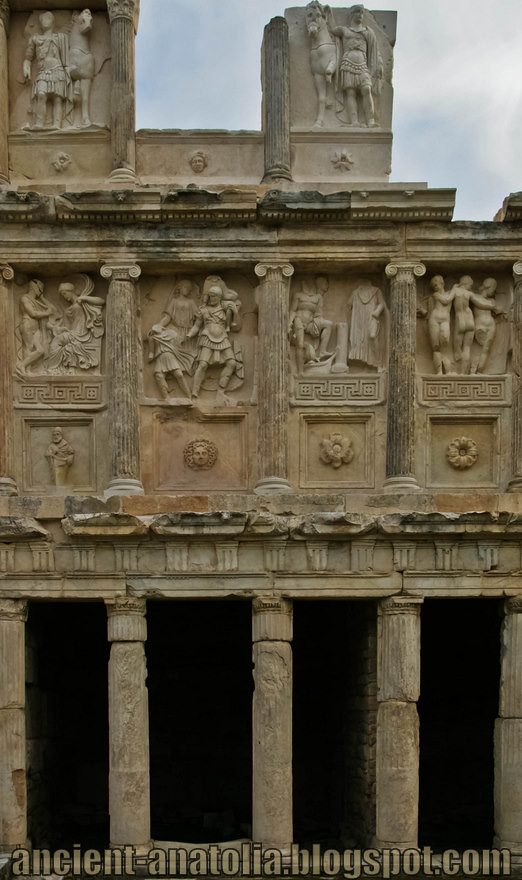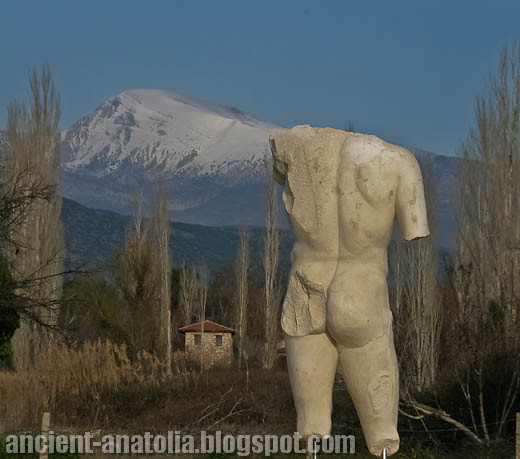
The ancient city of Aphrodisias is one of the most important archaeological sites of the late Hellenistic and Roman period in Turkey. Aphrodisias was named after Aphrodite, the Greek goddess of love, who had here her unique cult image, the Aphrodite of Aphrodisias, the city's patron goddess. Famous for its its marble sculptors, Aphrodisias enjoyed a long and prosperous existence from the first century BC to the sixth century AD. Today, many of the city's ancient monuments remain standing, and excavations have unearthed an unusual number of marble statues and inscriptions, as well as buildings and other artifacts.
 According to the Byzantine encyclopedic compilation called the Suda, before being known as Aphrodisias, the city had held three previous names: Lelégōn Pólis ("City of the Leleges"), Megálē Pólis ("Great City"), and Ninóē. The city was renamed Stauroúpolis ("City of the Cross") in around 640. Its site is located near the modern village of Geyre, Turkey, about 230 km from İzmir, close to Pamukkale, Denizli.
According to the Byzantine encyclopedic compilation called the Suda, before being known as Aphrodisias, the city had held three previous names: Lelégōn Pólis ("City of the Leleges"), Megálē Pólis ("Great City"), and Ninóē. The city was renamed Stauroúpolis ("City of the Cross") in around 640. Its site is located near the modern village of Geyre, Turkey, about 230 km from İzmir, close to Pamukkale, Denizli.The city was built near a marble quarry that was extensively exploited in the Hellenistic and Roman periods, and sculpture in marble from Aphrodisias became famous in the Roman world. Many examples of statuary have been unearthed in Aphrodisias, and some representations of the Aphrodite of Aphrodisias also survive from other parts of the Roman world, as far afield as Pax Julia in Lusitania.
The Sebasteion
 The Sebasteion is located to the east of the city center, opposite the North Agora, on the eastern side of a main north-south street that ran past the Tetrapylon to the Theater.
The Sebasteion is located to the east of the city center, opposite the North Agora, on the eastern side of a main north-south street that ran past the Tetrapylon to the Theater. The Propylon was a two-storeyed columnar screen with projecting aediculae that connected the North and South Buildings to give the complex a continuous monumental facade facing onto the street. The gate carried a series of Julio-Claudian portrait statues, as well as statues of Aeneas and Aphrodite Prometor--in her role as "Foremother"of the Roman emperors.
Sebasteion was discovered by chance, after expropriation of Geyre village houses. Sebasteion is a name derived from Sebastos –Augustus’ equivalent in Helen language. This place was devoted to Emperor Augustus and emperors from his family and also goddess Aphrodite.
The Sebasteion, excavated in 1979-81, was a grandiose temple complex dedicated to Aphrodite and the Julio-Claudian emperors. Its construction stretched over two generations, from ca. A.D. 20 to 60, from the reign of Tiberius to that of Nero. The complex was paid for by two of the leading Aphrodisian families. Leading to a Corinthian temple, a narrow processional way (90 X 14 m) was flanked by two portico-like buildings, each three-storied (12 m high), with superimposed Doric, Ionic, and Corinthian orders, and decorated with a long series of figured marble reliefs. More than seventy of the 190 reliefs that the project required were recovered in the excavation. They featured Roman emperors, Greek myths, and a series of personified ethne or 'nations' of Augustus' world empire, from the Ethiopians of Africa to the Callaeci of western Spain. This remarkable series of reliefs is unique in content, preservation, and extent.

Sculptures of Sebasteion
The Aphrodisian sculptors became renowned and benefited from a plentiful supply of marble close at hand. The school of sculpture was very productive. Much of their work can be seen around the site and in the museum. Many full-length statues were discovered in the region of the agora, and trial and unfinished pieces pointing to a true school are in evidence.
The engaged facades of both the North and South Buildings were decorated in their upper two storeys with large marble reliefs for their entire lengths. The project required a total of two hundred panels that carried lifesize figures in high relief, either single statuesque figures or two to four figures composed in narrative scenes. They represent a range of mythological, allegorical, and imperial subjects designed broadly to put on display the seamless accommodation of a keenly emperor-friendly city with Roman imperial power.

The reliefs of the two buildings had very different programs and used different designers and executing workshops. And, although there was no overriding unified program, the subjects of the reliefs are divided into distinct themes and categories of subjects according to the four registers made by the two levels in each building.
Of the reliefs from the North Building, which collapsed earlier and was cleared while the South Building was still in use, much less survives; but enough is preserved to reconstruct its broad program. The upper storey had imperial and allegorical subjects, while the lower storey carried a series of conquered peoples and places of the Roman empire, each treated as a single statuesque female personification standing on an inscribed base. The inscriptions record peoples from Spain in the furthest west to the Arabs and Judeans in the east. There were fifty such figures, and their designs were no doubt borrowed directly from a monument in Rome.
The South Building was never substantially cleared after its final collapse, and more than sixty of its reliefs survive. The upper‘ storey reliefs juxtaposed traditional Greek gods with Roman imperial scenes and figures of victory. The Roman emperors from Augustus to Nero are treated in a strikingly elevated, Hellenistic manner, designed to present them as part of a new enlarged Olympian pantheon -- an idea captured in the phrase of one of the inscriptions which dedicated the building "to the Olympian god-emperors" ( tois theois Sebastois Olympiois ). Several of these reliefs highlight the conquests of Claudius and the young Nero.
The lower storey reliefs featured a remarkable series of forty-five Greek mythological scenes. Many were arranged in broad groupings of familiar scenes of favorite figures, such as Herakles and Dionysos, but there was no single sequential mythological program. Towards the east end, however, as one approached the Temple, there was a greater concentration of sacrifice scenes and of Rome-related myths, such as those featuring Anchises and Aeneas. And here the design made explicit what is implied in the whole complex, the close connection between Greek myth-history in the lower level and the godlike Augustan regime in the upper storey. In spite of the wide range of styles and levels of execution between individual reliefs, it was perhaps this juxtaposition of Greek and Roman, of myth and history, moulded visually by style and iconography into a single continuum, that was the most striking effect of the complex viewed as a whole.
80 of 200 sculptures are on exhibit in the Museum of Aphrodisias since June 2008. +
